|
Since Ruger introduced their Vaquero single action revolver in 1993,
it has become one of the most popular handguns used in the growing sport of
Cowboy Action Shooting, and has also proven to be a hit with outdoorsmen
and hunters who want a rugged and reliable sidearm.
A couple of months ago, Ruger announced a major redesign of the Vaquero,
calling the new revolver, interestingly enough, the New Vaquero. I
immediately proceeded to beg Ruger for a test gun, and it arrived yesterday
as I write this. The New Vaquero will first be offered chambered for
the .357 Magnum/.38 Special and the .45 Colt cartridges, with the test gun
received being the latter. The .357 can be had in blued/case-colored or
bright stainless, with barrel lengths of four and five-eighths or five and
one-half inches. The .45 Colt will be offered in the same choice of
finishes and barrel lengths, with the addition of a seven and one-half inch
barrel length option. The test gun has a five and one-half inch
barrel, and is from regular production. It is not a prototype sample. The
guns are in full production as this is being written.
While shooters have taken to the original
Vaquero in droves, some have complained that the revolver was a
bit too large. The original Vaquero was built on the same sized
frame as the New Model Blackhawk that was introduced in 1973,
and has proven to be built like a tank. The Blackhawks and
Vaqueros will digest heavy loads that would wreck most sixguns
in short order.
The New Vaquero is built on the same size frame
as Rugerís beloved original
.357 Magnum Blackhawk. That frame size was discontinued
with the introduction of the new Model Blackhawk in 1973, when
Ruger began building their .357 Blackhawks on the same frame as
the larger calibers. The smaller frame size of the New Vaquero
is lighter and handier than the original Vaquero. It is almost
as small as the Colt Single Action Army revolver and its
replicas that are popular with Cowboy Action competitors. The
New Vaquero combines the handy size of the other sixguns with
the ruggedness and durability of a Ruger. In the world of single
action hand gunning, Ruger has an enviable reputation for
building sixguns that last forever, withstanding heavy use
without breaking action parts.
The following chart compares the size of the New
Vaquero cylinder and frame with that of similar revolvers.
Dimensions are listed in inches.
| |
Colt SAA |
U.S. Firearms SAA |
Old Vaquero |
New Vaquero |
Old Model .357 Blackhawk |
| Cylinder Diameter |
1.652 |
1.674 |
1.732 |
1.675 |
1.672 |
| Cylinder Length |
1.607 |
1.625 |
1.703 |
1.610 |
1.602 |
| Frame Window Height |
1.672 |
1.690 |
1.763 |
1.700 |
1.700 |
As can be seen in the chart, the dimensions of the New Vaquero are quite a
bit smaller than the old Vaquero, and are very close in size to the US
Firearms Single Action Army and the original .357 Blackhawk, both
of which are slightly larger than the Colt. Some of the heavy
bulleted Plus P class of .45 Colt ammunition are too long for the New
Vaquero cylinder, which is a good thing. I was relieved, however, to find
that my favorite standard .45 Colt handload using the Mt.
Baldy 265 grain Keith style bullet fit the cylinder perfectly. The
New Vaquero has cylinder walls that are thinner than those on the .45
Blackhawks and original Vaqueros, and while stronger than the Colt SAA, the
New Vaquero should not be used with the heavy loads that are listed as
"Ruger Only" in some hand loading manuals. As far as using other
heavy commercial loads that exceed industry pressure limits for a .45 Colt,
do not use them in the New Vaquero until you have checked with the maker of
the ammunition regarding its suitability for this revolver.
Besides the new smaller frame of the New Vaquero, there are a couple of
other improvements that make this sixgun better than the original. Unlike
any other Ruger Blackhawks, Single-Sixes, or Vaqueros built since 1973, the
new Vaquero has chambers that align properly with the loading gate for
easier loading and unloading of the cylinder. On the other sixguns, when
the cylinder was rotated until it "clicked", it had turned too
far, and had to be rotated completely around to align the chamber with the
loading gate. In the New Vaquero, Ruger has incorporated a cylinder hand
that retracts, and added a cylinder index button that is spring loaded. It
works to perfectly align the chambers with the loading gate, just like on
the Old Model Rugers that were built before 1973.
The New Vaquero also has a redesigned hammer that has a longer, more
upswept shape for easier cocking of the action. The hammer spring has also
been modified in the new design to allow for easier cocking. The action on
this New Vaquero was very smooth, and the trigger pull released crisply at
just three pounds and five ounces, right out of the box. The
barrel/cylinder gap measures an even four one-thousandths (.004) of
an inch.
The shape of the ejector rod button has also been changed from round to a
crescent shape, which is both easier to use and better looking than the
round type button. The New Vaquero wears the same style of fixed sights as
on the older version, being a square notch rear and a rounded front.
The New Vaquero still employs Rugerís transfer bar safety that allows the
gun to be safely carried with a full six rounds in the cylinder.
Ruger has incorporated a key actuated action lock into the New Vaquero.
Like many gun manufacturers, this has become necessary due to idiotic laws
that are being passed in many parts of our country requiring firearms to
have such a device. Unlike those found on most guns, the Ruger system is
unnoticed and detracts in no way from the lines or appearance of this
revolver. The lock is hidden beneath the grip panels. The key has a
built-in screwdriver to remove the right grip panel. Once the grip panel is
removed, the key is inserted and rotated to lock the action of the New
Vaquero. If the owner desires, the grip panel has an indention on the
inside surface to mark the location to drill a 3/16-inch hole to allow
access to the lock without removing the grip panel. This internal lock can
be utilized if desired, or simply ignored by those who do not need such a
device. It is the best of both worlds. It perfectly answers the
requirement for such a lock, without affecting those of us who
despise such devices on our sixguns.
The test gun has a nice semi-bright blue-black finish to the barrel,
cylinder, and grip frame, and a case-colored finish to the cylinder frame.
The sides of the blued hammer and trigger are polished bright. The
case-coloring on the frame looks very good, with the exception of one
bright spot on the left side, that is much lighter than the rest of the
frame. I would not call it a flaw, but it does look a bit out of place.
Overall, the sixgun looks very good.
Now comes what I consider the best feature of the New Vaquero: the grip
frame. On this new sixgun, Ruger has returned to the much adored shape and
size of the original XR3 grip, which was first used on the 1851 Colt Navy
revolver. I have always preferred the original XR3 grip to the XR3-RED
(redesigned) grip that was introduced in 1962. To my hand, no Ruger points
and handles like the beloved old Flattops that had the XR3 grip frame. Now,
the New Vaquero returns to that same shape and feel of the originals.
Finally! In fact, I tried a set of grip panels from an old Flattop on the
New Vaquero. While the alignment pin was different, the shape was near
perfect. In the photos, I laid the grip panel from the New Vaquero over
both an original XR3 grip panel and also over one from a Colt SAA.
The shape is the same. The new grip frame is the first XR3 to be made of
steel, and the New Vaquero is a delight to handle. Just like the old Colts,
it points like the finger of God. The slim grip panels on this sixgun are
made of checkered hard rubber, and have a Ruger Eagle molded in.
After taking pictures and measurements, I spent most of today shooting the
New Vaquero. I am now completely out of standard .45 Colt ammunition, and
all of the brass is in the tumbler being cleaned to load up for tomorrow,
when I again will extensively shoot the new sixgun. Butch Kent and Andrew
Felt also stopped by today to help me shoot this New Vaquero, and both
agreed that it is a winner. Accuracy testing was done early, with most of
the day spent plinking at rocks and a bowling ball that Andrew brought
along.
I was very impressed by the accuracy of the New Vaquero. Ruger has in
recent years produced .45 Colt cylinder throats that have proven to be too
tight for best accuracy with cast lead bullets, and I have routinely opened
up the throat dimensions on most of my .45 Colt chambered Rugers.
The chamber throats on this New Vaquero are perfectly sized, and each
chamber throat is exactly like the others. All six chambers will allow a
.452" diameter bullet to slip easily but snugly into the throat.
This was a pleasant and very unexpected surprise, and most likely
contributed to the excellent accuracy of the revolver. The handload using
the 265 grain Keith Mt. Baldy bullet loaded over nine grains of Alliant
Unique powder in mixed cases would group into 1-3/8 inches at
twenty-five yards all day. Lightly loaded 200 grain round nose bullet
loads would only group into just under three inches at twenty-five yards,
but that load has not been accurate in any gun tested. Most
importantly, the Keith load grouped exactly at point of aim for me at the
twenty-five yard range. I could not be happier with the accuracy
performance of this Ruger. As expected, reliability was perfect.
With this New Vaquero, Ruger has corrected the only complaints that I have
ever had about the New Model .45 Colt Vaqueros and Blackhawks. The chamber
throats are now perfectly sized, the chambers line up just right for quick
and easy loading and unloading, and we now have the return of the
best-handling Ruger grip frame ever produced; the XR3. As always, the New
Vaquero is a good value, offering a lot of sixgun for the money.
In my opinion, Ruger did everything right with this New Vaquero. It has the
reliability and durability built in that Ruger is famous for, along with
the handling qualities of the original Flattop .357 and the frame style of
the Colt Single Action Army. It is a great sixgun, and I will be
sending Ruger a check for this one. I canít make a better recommendation
than that.
Look for a test soon on the 50th Anniversary Flattop .357 Magnum. I canít
wait to get my hands on one of those babies!
Check out the full line of Ruger products
here.
You can order the excellent Keith bullets online
at: www.mtbaldybullets.com.
Jeff Quinn
|
To locate a dealer where you can
buy this gun, Click on the DEALER FINDER icon at: |
|

|
  
Got something to say about this article? Want to agree (or
disagree) with it? Click the following link to go to the GUNBlast Feedback Page.
|
|
Click pictures for a larger version.
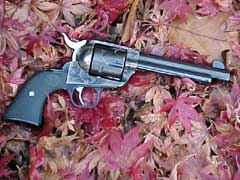
Ruger's New Vaquero sixgun.
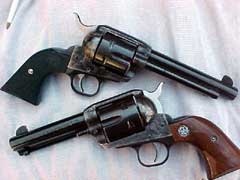
Ruger's New Vaquero (top) compared to the original
Vaquero (bottom).
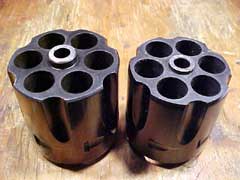
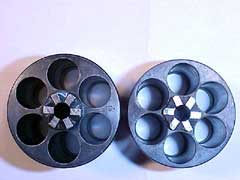
Ruger's New Vaquero cylinder (right) compared to the
original Vaquero's cylinder (left).
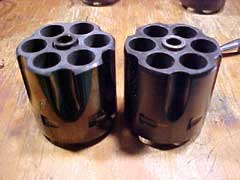
USFA SAA's cylinder (left) compared to the Ruger's New
Vaquero (right).
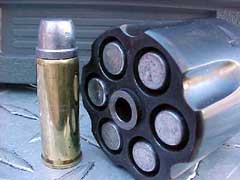
While shorter than the original Vaquero's cylinder, the
New Vaquero's cylinder is still long enough to accept Jeff's
favorite 265-grain Mt. Baldy Keith-style bullet.
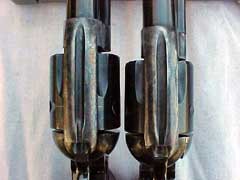
The frame size difference between the original Vaquero
(left) and the New Vaquero (right) is readily apparent.
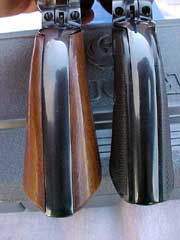
Also readily apparent in comparison is the difference in
grip panel
thickness between the original Vaquero (left) and the New
Vaquero (right).
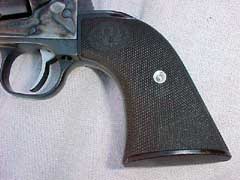
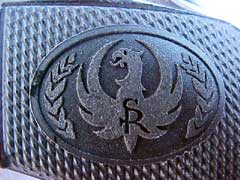
The New Vaquero features checkered hard rubber grips
with Ruger logo.
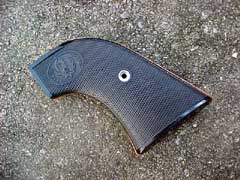
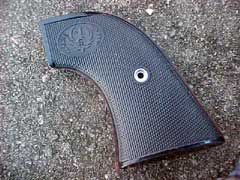
The long-hoped-for return of Ruger's original XR3 grip
design is shown in these pictures. Top picture shows a New
Vaquero grip panel laid over an original Ruger XR3 grip panel,
and bottom picture shows a New Vaquero grip panel laid over a
Colt SAA grip panel.
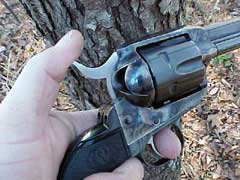
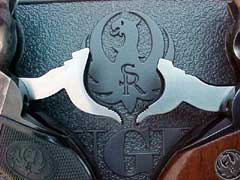
Ruger's New Vaquero (top picture and left bottom
picture) features a more upswept and comfortable hammer design
than the original Vaquero (right bottom picture).
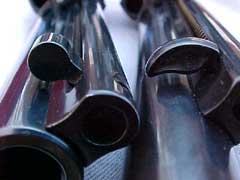
Another nice touch is the "crescent-style"
ejector rod button of the New Vaquero (right) as compared to
the round design of the original Vaquero (left).
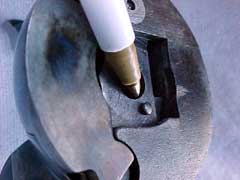
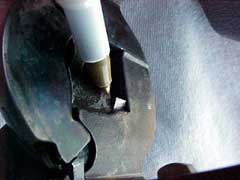
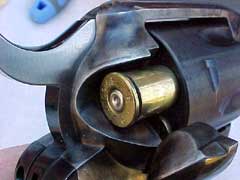
Ruger's New Vaquero features an ejector alignment pawl
with a fully-retracting hand (top), as compared to the
projecting hand of the original Vaquero (middle), allowing
proper alignment of the ejector rod (bottom).
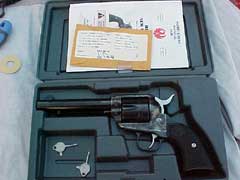
Ruger's New Vaquero comes with a Ruger hard plastic
case, instruction manual, and keys for Ruger's key lock
system.
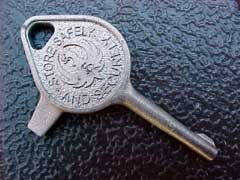
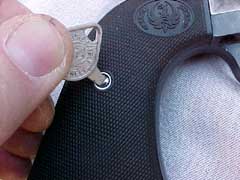
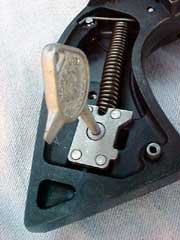
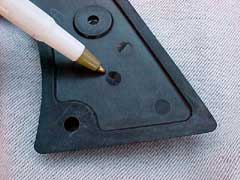
Ruger's ingenious (and totally unobtrusive) locking
system.
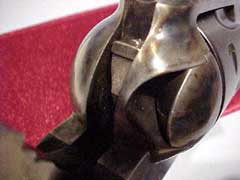
The New Vaquero also features Ruger's transfer bar
safety system.
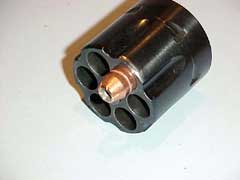
Cylinder throats are perfectly sized to allow a
.452" bullet to slip into the chamber throat, a welcome
design change that is a great aid to accuracy.
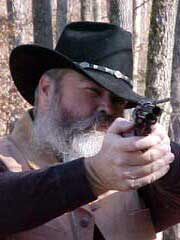
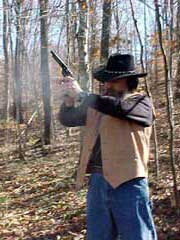
Author found the New Vaquero to be a very handy-sized
and accurate package.
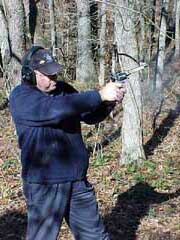
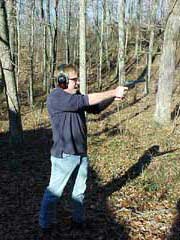
Our cousin Butch Kent (top) and Andrew Felt (bottom)
also approved of the New Vaquero.
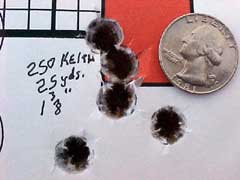
1-3/8" 25-yard group is representative of the good
accuracy of the Ruger New Vaquero.
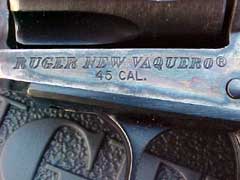
Ruger's New Vaquero heralds many design changes for
which sixgunners like Jeff have long hoped. Ruger has done
everything right with the new Vaquero, and we can't wait to
see what's next from Ruger!
|
![]()